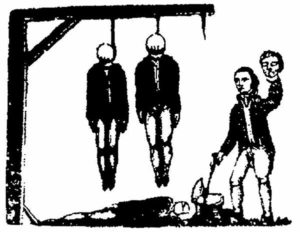 I was intrigued when I discovered that I am distantly related to the last person beheaded in England.
I was intrigued when I discovered that I am distantly related to the last person beheaded in England.
The year is 1817 and the place Derbyshire. Isaac Ludlam was one of three men executed at Derby gaol. His head was cut from his corpse and shown to the thousands in the crowd. This was not a story handed down in the family nor am I aware that my parents or grandparents were aware of it.
So who was Isaac Ludlam and what was his crime?
Ludlam was no young hothead.
He was 52 years old, married, the father of many children and a respected Methodist lay preacher known as the Elder. He was a farmer whose crops had failed who earned a living as a stone-getter, a quarryman. Carrying a home-made pike he participated with three of his sons in the last armed uprising in England. He was one of the Pentrich martyrs who, together with Jeremiah Brandreth and William Turner was executed for high treason.
This was their sentence:
That you … be taken to the jail from which you have been brought, and thence drawn on a hurdle to the place of execution, where you shall be severally hanged by the neck till you be dead, and afterwards your heads be severed from your bodies, and your bodies be divided into four quarters, and placed at his Majesty’ disposal; and may the Lord God of all mercy have compassion upon you
In an act of clemency (!) the Prince Regent commuted the sentence to drawing, hanging and beheading.
This is the back story
In 1815 the long Napoleonic Wars finally ended with the defeat of the French at the Battle of Waterloo. 300,000 soldiers and sailors were demobilized at the same and started looking for work, It was hard to find because of a post-war slump and the accelerating pace of the industrial revolution that was replacing labour with machinery and employing women and children to do the work.
William Turner was a former soldier

The industrial revolution destroyed a way of life for the skilled artisan. In 1760 a Midland frame knitter had independence, freedom and relative prosperity. The introduction of factories and machines signaled the end of that economic autonomy. Prices dropped and the new labour-saving machinery meant profits for the mill owners and wage dependence for the now de-skilled workers.
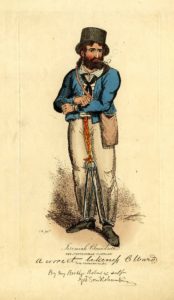
Jeremiah Brandreth was a former soldier, an unemployed stocking knitter and a former luddite.
The end of the war brought a recession in the iron and textile industries which were among Derbyshire’s main employers. A Parish Relief to help the destitute placed an undue tax burden on those who remained employed, bankrupting many small farmers and other workers.
The 1790s through the 1820s were marked by radical change. The industrial revolution changed the economic realities and the way of life for the working class while also expanding the middle class. The revolutionary ideas of the American and French Revolutions helped shape the debate and threatened the philosophical foundations of British society. Radical newspapers and political societies fomented an environment of unrest. Thousands were close to starvation and desperate.
Population shifts and the growth of industrial cities left many new industrial towns without parliamentary representation. Large industrial cities like Leeds, Birmingham, and Manchester did not have a single MP between them, whereas ‘rotten boroughs’ such as Dunwich in Suffolk (which had a population of 32 in 1831) were still sending two MPs to Westminster. The British electoral system was unrepresentative and outdated.
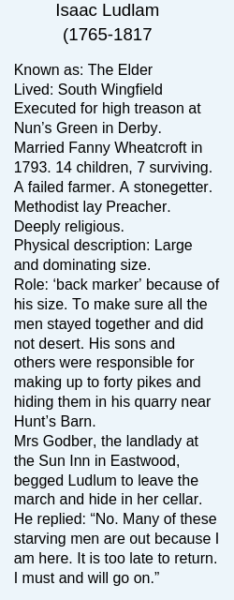 The monarchy was in disarray with King George mentally indisposed and his son, the Prince Regent widely disliked for his self-indulgence and extravagance. Amid the widespread poverty and desperation, a middle-class reform movement gathered momentum. A network of underground societies – Hampden Clubs – dedicated to social and political reform sprang up all over England. The government viewed them as dangerous and potentially seditious.
The monarchy was in disarray with King George mentally indisposed and his son, the Prince Regent widely disliked for his self-indulgence and extravagance. Amid the widespread poverty and desperation, a middle-class reform movement gathered momentum. A network of underground societies – Hampden Clubs – dedicated to social and political reform sprang up all over England. The government viewed them as dangerous and potentially seditious.
Radical newspapers spread the ideas of change, reform, and revolution. William Cobbett’s Political Register became the newspaper of the working class and actively urged the workers to stand up for their rights and demand an active role in government. In January of 1817 a new radical newspaper, The Black Dwarf, began publishing. The government imprisoned the editor, Thomas Wooler on charges of seditious libel.
And then the crops failed.
The Tambora (Indonesia) volcano of 1815 wrought havoc with global weather patterns and darkened the skies across the northern hemisphere. There was frost throughout the year, in Derbyshire snow fell in June and 1816 was known as the year without a summer. Starvation loomed and people were desperate.
Isaac Ludlam was a failed farmer with a large family to feed.
There were violent disturbances and food riots across the country. The government feared the worst and reacted with repression, not relief. Habeas Corpus was suspended in February 1817, enabling the government to hold people in prison without trial. In March, meetings of more than 50 people were banned and spies were dispatched from the Home Office to report on potential trouble and sedition.
What happened at Pentrich?
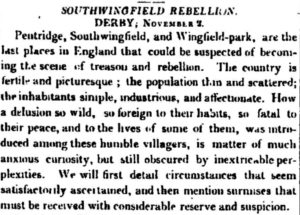
William Oliver played the role of an enthusiastic revolutionary as he traveled the country. He was actually a paid informer in the employ of the Home Secretary, Lord Sidmouth.
Oliver met Thomas Bacon, a veteran radical and a member of the Pentrich Hampden Club, one of a network of underground societies dedicated to political and social reform. Bacon took Oliver’s lies of an imminent nationwide uprising at face value. Bacon also met Jeremiah Brandreth – an unemployed stocking maker from Sutton-in-Ashfield who believed that a national revolt was planned and ready.
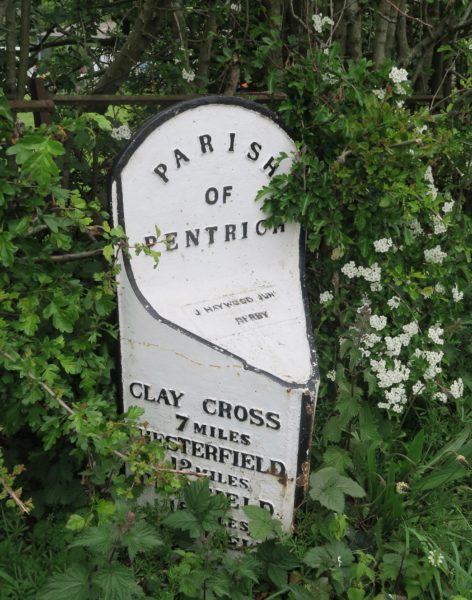 Brandreth was known as the “Nottingham Captain” and on June 8th, 1817 he addressed a meeting at the White Horse Inn owned by Nanny Weightman, Thomas Bacon’s sister, in Pentrich.
Brandreth was known as the “Nottingham Captain” and on June 8th, 1817 he addressed a meeting at the White Horse Inn owned by Nanny Weightman, Thomas Bacon’s sister, in Pentrich.
Brandreth urged those attending to march on Nottingham where he said they would be joined by hundreds of others and move along the River Trent to Newark and on to London.
Brandreth said that each man who joined the march would receive 100 guineas, bread, beef, and a pint of rum when they arrived in Nottingham. He took out a map that showed the route and shared a fight song. He claimed that hundreds were ready to join them as part of a nationwide uprising against the government.
The plan was to attack the troop barracks at Nottingham and urge the soldiers to join the uprising. Their demands were vague but included wiping out the national debt, the establishment of a provisional government, and relief for the poor.
Brandreth’s speech was witnessed by several informants who later testified that they heard talk of an uprising but were too frightened to report it to any magistrate.
It Begins
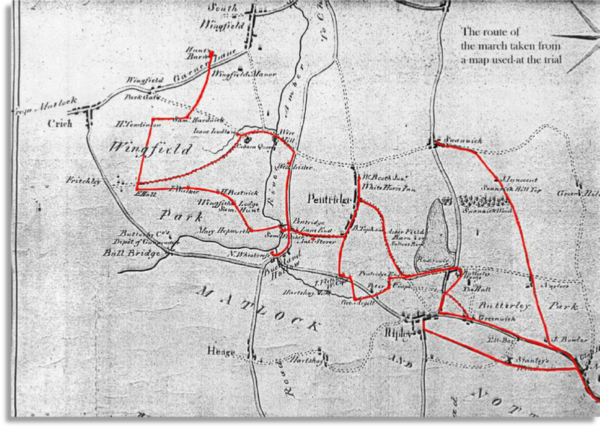
The evening of June 9th was cold and rainy and at about 10 pm several scores of men gathered at Hunt’s Barn, a roofless ruin, in South Wingfield to begin the march. The plan was to visit houses and businesses along the way to gather men and arms for the struggle ahead.
At one point the group split up and Brandreth’s group went to the home of Widow Hepworth. It was here that the only fatality of the night occurred.
According to a London Times account of November 2nd, Brandreth intended to shoot Mrs’Hepworth’s son, whom he hated as an overseer and whom he suspected of being determined to refuse to hand over arms.
The doors and windows were locked and Brandreth demanded that they be let in or he would start shooting. Robert Walters, a servant of Mrs. Hepworth’s, went to the kitchen and started to put on his boots. Brandreth shot through the window in the door and hit Walters who later died. No one was charged with his murder.
They moved on to the Butterley ironworks where Brandreth had said they were going to take over the factory to make weapons for the revolt. The shop foreman, Mr. Goodwin, stood up to Brandreth and told the men to come to their senses and go home. Some of the men heeded Goodwin and broke ranks.
At the next village, Codnor, they were now about 200 strong and they took over the three public houses and ate and drank. There were other pub stops along the way and, pikes and pistols aside, descriptions of the march suggest a rather riotous and extended pub crawl.
Along the way, they passed through the coal-mining village of Eastwood, the birthplace of D.H. Lawrence, where some residents boarded up their houses and hid in the woods. They stopped at The Sun Inn, where the landlady – Mrs. Godber – entreated Ludlam to leave the mob and hide in her cellar. He replied:
No. Many of these starving men are out because I am here. It is too late to return. I must and will go on..
By early morning the original group had marched 12 miles and were close to the village of Kimberley at Giltbrook when they saw the mounted men of the 15th Regiment of Light Dragoons. The marchers dispersed in panic. The Pentrich Revolution was at an end.
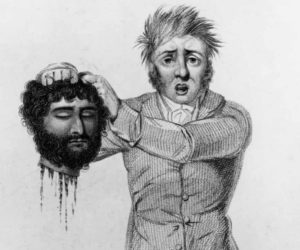
The marchers were tracked down and arrested. Forty-seven of them stood trial before the lord chief justice and a carefully picked jury of local landowners.
The trial lasted 10 days. Four men were sentenced to death (George Weightman’s sentence was commuted) and 23 were sentenced to be transported to Australia. None were to see their homes again.
To expunge their memory, and in vengeful retribution, the local landowner – the Duke of Devonshire – demolished their homes and evicted their families. A note in the 1821 Census reads:
“The population has decreased by one-third in the Township of Pentrich since 1811; which is said to be owing to the insurrection which took place there in 1817, in consequence of which the Duke of Devonshire’s agents destroyed many of the houses.”
On November 7th, 1817, Brandreth, Ludlam, and Turner were taken from Derby Gaol to Nun’s Green where they were executed by being slowly hanged and then beheaded. Turner’s last words before his execution were: “This is the work of the Government and Oliver”.
Ludlam and Turner spent the night before their execution in prayer. As Ludlam ascended the ladder to the scaffold, he prayed, and while the rope was being placed about his neck he raised his voice in supplication:
O Lord, forgive my sins, and receive my soul, and grant that I may meet all this great concourse of people in Heaven. Bless the King of this nation, bless the people, bless all the people high and low, rich and poor, bound and free; yea, bless all, from the King upon his Throne down to the meanest subject in the realm; and may this awful dispensation be made a blessing to thousands and tens of thousands. O Lord, receive my spirit!
The Chaplain read a prayer and they recited the Lord’s Prayer. The minister stepped down and the executioners covered the faces of the men with caps. Each of them exclaimed at this moment, “Into thy hands, O God! I commit my spirit.” Ludlam continued to pray until the last moment.
“This is the work of the Government and Oliver”
The political fervor and ferment of the revolt were real and the plight of the destitute genuine and extreme. The Pentrich Revolution, however, was deliberately provoked by the Tory government through its paid informant William Oliver. His role of disinformation and treachery was revealed by the investigative journalism of the Leeds Mercury in July 1817 much to the outrage of its readers who were shocked at such government deception and betrayal. None of that was introduced at the trial except by the last words of William Turner on the scaffold:
“This is the work of the Government and Oliver”
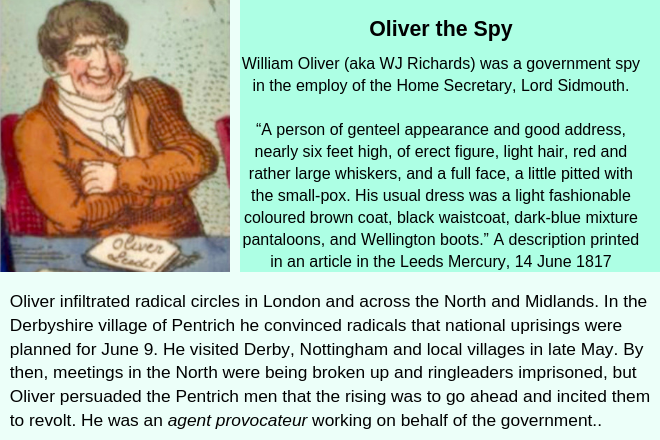
William Cobbett later wrote: “The employers of Oliver might in an hour have put a total stop to [the] preparations and blown them to air. They wished not to prevent but to produce those acts.” The uprising was the perfect pretext for further repression.
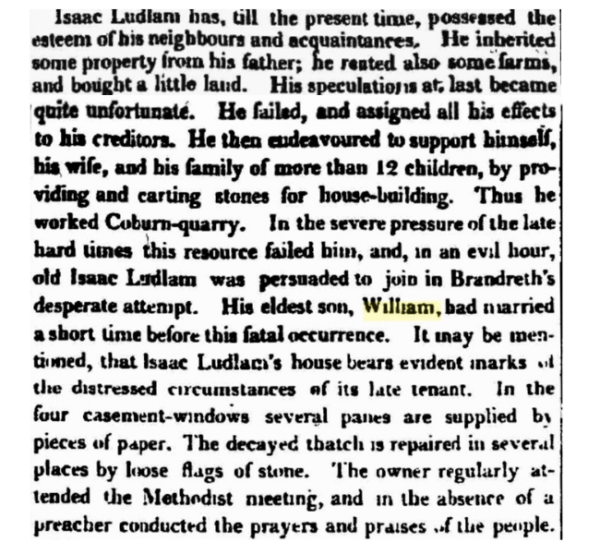
Two hundred years later
We visited Pentrich in the spring of the 200th anniversary of the uprising.
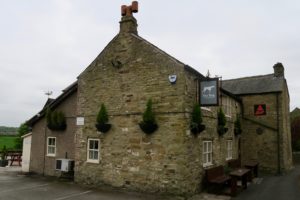
We had a good lunch at the Dog Inn (known as the Spaniel Dog in 1817) where a plaque on the wall names those sentenced along with their trades.
There’s a marker outside on the wall of the pub that declares that the rebels met there. Inside, they were surprisingly unable to direct us to the other markers on the Pentrich trail.
We found them anyway. 
Growing up, I never heard of what happened at Pentrich – not at school nor at home. I find it hard to imagine that my grandmother, born Frances Clayton- who grew up in Victorian Derbyshire – would not have heard of the story from local lore or family stories.
She spoke often of the hardships of growing up on a tenant farm the oldest of seven. She excelled at school and at 17 she was a pupil teacher. Within a year, she had won a scholarship to train as a teacher at Stockwell College, in London. I remember her as a force to be reckoned with.
What would she have made of the family connection to the Pentrich Revolution? Did she know? It’s a question to which I would love to know the answer, but never will.
The Pentrich three were martyrs to some and traitors to others. A source of pride or shame. Or enforced shame by those who might have feared further reprisals from vengeful landowners.
As for my grandmother – I know she was proud of her Derbyshire background. For her, it was the moral and literal backbone of respectable England. When she owned a small hotel in Swanage in the mid-century she named it Chatsworth after the grand ancestral home of the Duke of Devonshire. (It’s now a student field center.) There’s an irony in that.
This was all brought back to mind by seeing Mike Leigh’s film Peterloo about the massacre of peaceful protesters in St. Peter’s Field Manchester just two summers after the Pentrich uprising. See it if you can. Oliver the Spy has a starring role as a government spy and agent provocateur.
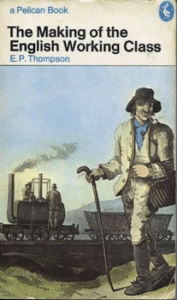
Read more about the cause of discontent and distress 1812-1822 here: http://www.historyhome.co.uk/c-eight/distress/distress.htm
Read more about the career of Oliver the Spy here: http://www.historyhome.co.uk/c-eight/distress/oliver.htm
Jeremy Brandreth: A True Englishman
https://theoldscholar.files.wordpress.com/2011/11/johnhenrydraftpaper2.pdf
E.P.Thompson: “The Making of the English Working Class”
https://uncomradelybehaviour.files.wordpress.com/2012/04/thompson-ep-the-making-of-the-english-working-class.pdf
For a detailed description of the execution based on a contemporary broadside; http://www.historyhome.co.uk/c-eight/distress/brandret.htm
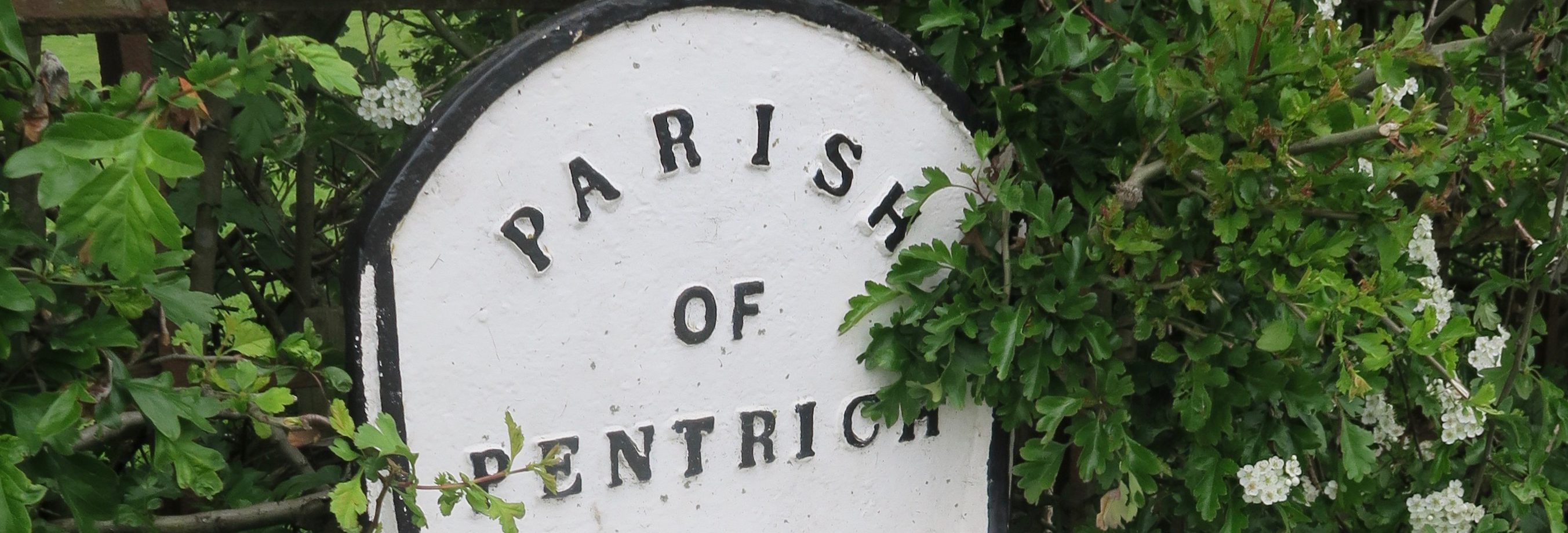
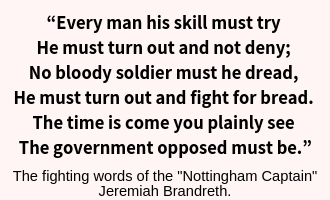


Thank you for your informative post.
Until a few days ago I had not realised that a cousin of my great great great grandmother, Elizabeth Ludlam, had been connected to anything like these events. I have been reading further with a growing sadness about the horrific end of a decent man.
Thanks Phil – There is actually a book – I have it somewhere – that lists all the descendants of the Ludlams. And as I suspect you have discovered there are some active Ludlam and Pentrich family sites.
It is indeed an horrific story.
Hello
I was interested to read about your relation to Isaac Ludlam, and to find your interesting website.
I too was astounded to find that I was descended from Hannah Ludlam, sister of Isaac, last man to be hung, drawn and quartered in England. I hate to think of Hannah’s agony for her brother on that day.
From Ancestry relatively recently unearthed, I found that my brother, sister and I are descendants of Ludlams: Isaac was the great-uncle of my grt. grandfather, William Elliott 1823-1907 ie Hannah was William’s grandmother.
I am investigating your website further-Love the Title and By-Lines!
Greetings from a distant cousin!
Thanks Deb. I think that means we must be distantly related! It is indeed a terrible story.